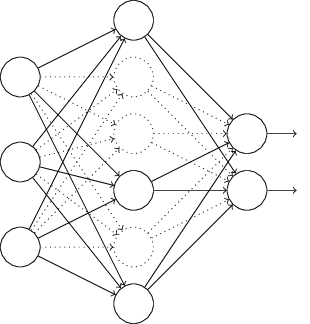Tensorflow学习笔记:基础篇(8)——Mnist手写集改进版(过拟合与Dropout)
Tensorflow学习笔记:基础篇(8)——Mnist手写集改进版(过拟合与Dropout)
前序
— 前文中,我们在三层全连接神经网络中使用了Tensorboard对模型训练中的参数与模型架构进行可视化显示
— 本文我们来说一个相对简单的问题:过拟合
Reference:正则化方法:L1和L2 regularization、数据集扩增、dropout,什么是过拟合?
过拟合
— 在机器学习中,我们提高了在训练数据集上的表现力时,在测试数据集上的表现力反而下降了,这就是过拟合。
— 过拟合发生的本质原因,是由于监督学习的不适定性。比如我们再学习线性代数时,给出n个线性无关的方程,我们可以解出来n个变量,但是肯定解不出来n+1个变量。在机器学习中,如果数据(对应于方程)远小于模型空间(对应求解的变量),那么,就容易发生过拟合现象。
解决过拟合的三种方式:
(1)增加训练数据集
(2)正则化
(3)Dropout
Dropout
正则化是通过修改代价函数来实现的,而Dropout则是通过修改神经网络本身来实现的,它是在训练网络时用的一种技巧。

假设我们要训练上图这个网络,在训练开始时,我们随机地“删除”一半的隐层单元,视它们为不存在,得到如下的网络:

保持输入输出层不变,按照BP算法更新上图神经网络中的权值(虚线连接的单元不更新,因为它们被“临时删除”了)。
以上就是一次迭代的过程,在第二次迭代中,也用同样的方法,只不过这次删除的那一半隐层单元,跟上一次删除掉的肯定是不一样的,因为我们每一次迭代都是“随机”地去删掉一半。第三次、第四次……都是这样,直至训练结束。
以上就是Dropout,它为什么有助于防止过拟合呢?可以简单地这样解释,运用了dropout的训练过程,相当于训练了很多个只有半数隐层单元的神经网络(后面简称为“半数网络”),每一个这样的半数网络,都可以给出一个分类结果,这些结果有的是正确的,有的是错误的。随着训练的进行,大部分半数网络都可以给出正确的分类结果,那么少数的错误分类结果就不会对最终结果造成大的影响。
代码示例
1、数据准备
import tensorflow as tf
from tensorflow.examples.tutorials.mnist import input_data
# 载入数据集
mnist = input_data.read_data_sets("MNIST_data", one_hot=True)
# 每个批次送100张图片
batch_size = 100
# 计算一共有多少个批次
n_batch = mnist.train.num_examples // batch_size
def variable_summaries(var):
with tf.name_scope('summaries'):
mean = tf.reduce_mean(var)
tf.summary.scalar('mean', mean)
with tf.name_scope('stddev'):
stddev = tf.sqrt(tf.reduce_mean(tf.square(var - mean)))
tf.summary.scalar('stddev', stddev)
tf.summary.scalar('max', tf.reduce_max(var))
tf.summary.scalar('min', tf.reduce_min(var))
tf.summary.histogram('histogram', var) ##直方图2、准备好placeholder
我们今天新建一个placeholder,取名为keep_prob,它的作用是控制实际参与训练的神经元比例,取值范围为0.0-1.0,若取1.0,表示100%神经元参与训练;若取0.6,表示60%神经元工作,以此类推。
with tf.name_scope('input'):
x = tf.placeholder(tf.float32, [None, 784], name='x_input')
y = tf.placeholder(tf.float32, [None, 10], name='y_input')
keep_prob = tf.placeholder(tf.float32, name='keep_prob')
lr = tf.Variable(0.001, dtype=tf.float32, name='learning_rate')3、初始化参数/权重
这里我们使用tf.nn.dropout()函数来实现Dropout,通过keep_prob参数控制
with tf.name_scope('layer'):
with tf.name_scope('Input_layer'):
with tf.name_scope('W1'):
W1 = tf.Variable(tf.truncated_normal([784, 500], stddev=0.1), name='W1')
variable_summaries(W1)
with tf.name_scope('b1'):
b1 = tf.Variable(tf.zeros([500]) + 0.1, name='b1')
variable_summaries(b1)
with tf.name_scope('L1'):
L1 = tf.nn.tanh(tf.matmul(x, W1) + b1, name='L1')
L1_drop = tf.nn.dropout(L1, keep_prob)
with tf.name_scope('Hidden_layer'):
with tf.name_scope('W2'):
W2 = tf.Variable(tf.truncated_normal([500, 300], stddev=0.1), name='W2')
variable_summaries(W2)
with tf.name_scope('b2'):
b2 = tf.Variable(tf.zeros([300]) + 0.1, name='b2')
variable_summaries(b2)
with tf.name_scope('L2'):
L2 = tf.nn.tanh(tf.matmul(L1_drop, W2) + b2, name='L2')
L2_drop = tf.nn.dropout(L2, keep_prob)
with tf.name_scope('Output_layer'):
with tf.name_scope('W3'):
W3 = tf.Variable(tf.truncated_normal([300, 10], stddev=0.1), name='W3')
variable_summaries(W3)
with tf.name_scope('b3'):
b3 = tf.Variable(tf.zeros([10]) + 0.1, name='b3')
variable_summaries(b3)
4、计算预测结果
prediction = tf.nn.softmax(tf.matmul(L2, W3) + b3)5、计算损失值
with tf.name_scope('loss'):
loss = tf.reduce_mean(tf.nn.softmax_cross_entropy_with_logits(labels=y, logits=prediction))
tf.summary.scalar('loss', loss)6、初始化optimizer
with tf.name_scope('optimizer'):
optimizer = tf.train.AdamOptimizer(lr).minimize(loss)
with tf.name_scope('train'):
with tf.name_scope('correct_prediction'):
correct_prediction = tf.equal(tf.argmax(y, 1), tf.argmax(prediction, 1))
with tf.name_scope('accuracy'):
accuracy = tf.reduce_mean(tf.cast(correct_prediction, tf.float32))
tf.summary.scalar('accuracy', accuracy)7、指定迭代次数,并在session执行graph
init = tf.global_variables_initializer()
merged = tf.summary.merge_all()
with tf.Session() as sess:
sess.run(init)
writer = tf.summary.FileWriter('./graphs/mnist', sess.graph)
for epoch in range(21):
sess.run(tf.assign(lr, 0.001 * (0.95 ** epoch)))
for batch in range(n_batch):
batch_xs, batch_ys = mnist.train.next_batch(batch_size)
summary, _ = sess.run([merged, optimizer], feed_dict={x: batch_xs, y: batch_ys, keep_prob: 1.0})
#这里同样将keep_prob使用字典形式传入,我们分别取0.6和1.0,运行两次,比较结果
writer.add_summary(summary, epoch)
test_acc = sess.run(accuracy, feed_dict={x: mnist.test.images, y: mnist.test.labels, keep_prob: 1.0})
train_acc = sess.run(accuracy, feed_dict={x: mnist.train.images, y: mnist.train.labels, keep_prob: 1.0})
#这里我们分别让它同时运行测试集与训练集,同时输出准确率进行比较,执行测试时,我们将keep_prob取为1,让神经元全部工作。
learning_rate = sess.run(lr)
if epoch % 2 == 0:
print("Iter" + str(epoch) + ", Testing accuracy:" + str(test_acc) + ", Training accuracy:" + str(train_acc))
writer.close()
运行结果
我们先将keep_prob设置为1.0训练模型,得到下图,发现Testing accuracy依然为0.98,Training accuracy达到0.996,这也不难理解,比较用training的数据集训练的模型,拿来测试自身的准确度肯定是很高的。
但是,我想请各位读者注意的是,Testing accuracy与Training accuracy的差值随着迭代次数增加,而逐渐扩大,说明产生了文章开头提到过拟合现象,即在训练数据集上的表现力时,在测试数据集上的表现力反而下降了。

我们再来看keep_prob设置为0.6的运行结果:

大家可以发现,Testing accuracy与Training accuracy较之前均有所下降,但是其之间的差值较之前有所改善,说明使用Dropout能够在一定程度上缓解过拟合现象,大家不妨尝试将keep_prob多取几个值进行比较一下~~
完整代码
import tensorflow as tf
from tensorflow.examples.tutorials.mnist import input_data
mnist = input_data.read_data_sets("MNIST_data", one_hot=True)
# 每个批次的大小
batch_size = 100
# 计算一共有多少个批次
n_batch = mnist.train.num_examples // batch_size
def variable_summaries(var):
with tf.name_scope('summaries'):
mean = tf.reduce_mean(var)
tf.summary.scalar('mean', mean)
with tf.name_scope('stddev'):
stddev = tf.sqrt(tf.reduce_mean(tf.square(var - mean)))
tf.summary.scalar('stddev', stddev)
tf.summary.scalar('max', tf.reduce_max(var))
tf.summary.scalar('min', tf.reduce_min(var))
tf.summary.histogram('histogram', var) ##直方图
with tf.name_scope('input'):
x = tf.placeholder(tf.float32, [None, 784], name='x_input')
y = tf.placeholder(tf.float32, [None, 10], name='y_input')
keep_prob = tf.placeholder(tf.float32, name='keep_prob')
lr = tf.Variable(0.001, dtype=tf.float32, name='learning_rate')
with tf.name_scope('layer'):
with tf.name_scope('Input_layer'):
with tf.name_scope('W1'):
W1 = tf.Variable(tf.truncated_normal([784, 500], stddev=0.1), name='W1')
variable_summaries(W1)
with tf.name_scope('b1'):
b1 = tf.Variable(tf.zeros([500]) + 0.1, name='b1')
variable_summaries(b1)
with tf.name_scope('L1'):
L1 = tf.nn.tanh(tf.matmul(x, W1) + b1, name='L1')
L1_drop = tf.nn.dropout(L1, keep_prob)
with tf.name_scope('Hidden_layer'):
with tf.name_scope('W2'):
W2 = tf.Variable(tf.truncated_normal([500, 300], stddev=0.1), name='W2')
variable_summaries(W2)
with tf.name_scope('b2'):
b2 = tf.Variable(tf.zeros([300]) + 0.1, name='b2')
variable_summaries(b2)
with tf.name_scope('L2'):
L2 = tf.nn.tanh(tf.matmul(L1_drop, W2) + b2, name='L2')
L2_drop = tf.nn.dropout(L2, keep_prob)
with tf.name_scope('Output_layer'):
with tf.name_scope('W3'):
W3 = tf.Variable(tf.truncated_normal([300, 10], stddev=0.1), name='W3')
variable_summaries(W3)
with tf.name_scope('b3'):
b3 = tf.Variable(tf.zeros([10]) + 0.1, name='b3')
variable_summaries(b3)
prediction = tf.nn.softmax(tf.matmul(L2_drop, W3) + b3)
# 二次代价函数
# loss = tf.reduce_mean(tf.square(y - prediction))
# 交叉熵代价函数
with tf.name_scope('loss'):
loss = tf.reduce_mean(tf.nn.softmax_cross_entropy_with_logits(labels=y, logits=prediction))
tf.summary.scalar('loss', loss)
# 梯度下降
# optimizer = tf.train.GradientDescentOptimizer(learning_rate).minimize(loss)
with tf.name_scope('optimizer'):
optimizer = tf.train.AdamOptimizer(lr).minimize(loss)
with tf.name_scope('train'):
with tf.name_scope('correct_prediction'):
correct_prediction = tf.equal(tf.argmax(y, 1), tf.argmax(prediction, 1))
with tf.name_scope('accuracy'):
accuracy = tf.reduce_mean(tf.cast(correct_prediction, tf.float32))
tf.summary.scalar('accuracy', accuracy)
merged = tf.summary.merge_all()
init = tf.global_variables_initializer()
with tf.Session() as sess:
sess.run(init)
writer = tf.summary.FileWriter('./graphs/mnist', sess.graph)
for epoch in range(21):
sess.run(tf.assign(lr, 0.001 * (0.95 ** epoch)))
for batch in range(n_batch):
batch_xs, batch_ys = mnist.train.next_batch(batch_size)
summary, _ = sess.run([merged, optimizer], feed_dict={x: batch_xs, y: batch_ys, keep_prob: 0.6})
writer.add_summary(summary, epoch)
test_acc = sess.run(accuracy, feed_dict={x: mnist.test.images, y: mnist.test.labels, keep_prob: 1.0})
train_acc = sess.run(accuracy, feed_dict={x: mnist.train.images, y: mnist.train.labels, keep_prob: 1.0})
learning_rate = sess.run(lr)
if epoch % 2 == 0:
print("Iter" + str(epoch) + ", Testing accuracy:" + str(test_acc) + ", Training accuracy:" + str(train_acc))
writer.close()